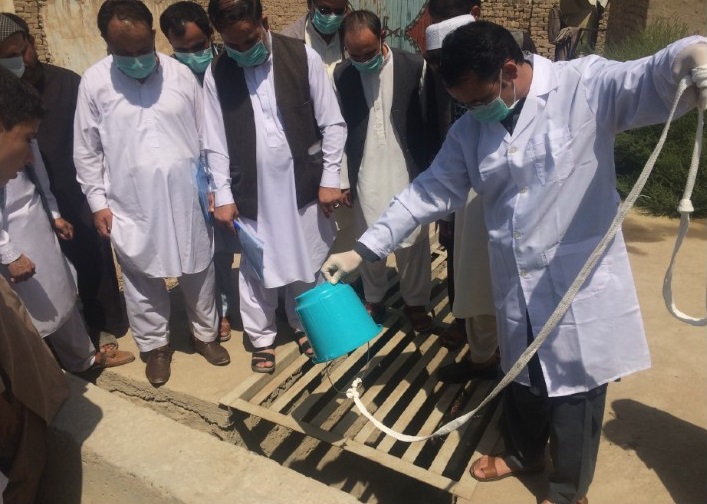 Environmental sampling from an open drain in Kabul city in August 2017. Samples are generally collected in the early morning when there is a higher flow of sewage. WHO/S.RamoKabul 23 September 2017 - A new environmental sampling site for wild poliovirus isolation has become operational in Kunduz province, expanding the reach of Afghanistan’s environmental surveillance network to all regions. This is the 20th site established for environmental surveillance since the collection and testing of sewage samples for poliovirus began in Afghanistan in 2013 with WHO support.
Environmental sampling from an open drain in Kabul city in August 2017. Samples are generally collected in the early morning when there is a higher flow of sewage. WHO/S.RamoKabul 23 September 2017 - A new environmental sampling site for wild poliovirus isolation has become operational in Kunduz province, expanding the reach of Afghanistan’s environmental surveillance network to all regions. This is the 20th site established for environmental surveillance since the collection and testing of sewage samples for poliovirus began in Afghanistan in 2013 with WHO support.
In 2017, from the 218 sewage samples collected from all sites, eight have tested positive for wild poliovirus, the latest collected in July from Lashkargah, capital of Helmand province.
“We began the expansion of the surveillance system in the most high-risk provinces of Kandahar and Helmand in the south where we have also doubled the frequency of sampling to every two weeks to increase the chances of picking up the virus where it circulates,” said Dr Hemant Shukla, Director of the Polio Programme at WHO Afghanistan. “Our next priority was to establish additional sites in the eastern region, and now environmental surveillance has expanded to nine provinces, covering all regions in Afghanistan.”
A sensitive surveillance system remains the cornerstone of polio eradication efforts. Environmental surveillance, the collection of sewage samples and testing them for poliovirus in the laboratory, helps to determine possible routes of transmission and enabling a swift response to stop further spread of the virus.
 WHO team supported a practical training session at a new sampling site in Kunduz city in August 2017. WHO/A.ZahedEnvironmental surveillance complements acute flaccid paralysis (AFP) surveillance which currently consists of a network of over 28 000 reporting volunteers and focal points, including health workers, teachers, religious leaders and traditional healers. Reporting volunteers detect and report children showing signs of polio, such as floppy or weakened limbs with rapid-onset of paralysis. Finding and stopping every last strain of the poliovirus requires sensitive AFP as well as environmental surveillance.
WHO team supported a practical training session at a new sampling site in Kunduz city in August 2017. WHO/A.ZahedEnvironmental surveillance complements acute flaccid paralysis (AFP) surveillance which currently consists of a network of over 28 000 reporting volunteers and focal points, including health workers, teachers, religious leaders and traditional healers. Reporting volunteers detect and report children showing signs of polio, such as floppy or weakened limbs with rapid-onset of paralysis. Finding and stopping every last strain of the poliovirus requires sensitive AFP as well as environmental surveillance.
In 2016, WHO and the Ministry of Public Health conducted a comprehensive assessment of existing environmental sampling sites, identifying new sites for expansion. Since the beginning of the year, WHO has supported the establishment of four new sampling sites to further boost Afghanistan’s surveillance capacity.
“Strengthened environmental surveillance has helped us to identify and locate wild polioviruses when they are circulating. Whenever virus is found in the environmental samples, WHO supports a strong response in that area, which includes vaccinating all target-age children to boost their immunity levels to protect them from polio and further strengthening routine immunization services in the area,” explains Dr Ali Ahmad Zahed, Surveillance Officer at WHO Afghanistan.
 Technical team from WHO and the Ministry of Public Health packs a sewage sample to be sent for further testing to the regional laboratory in Pakistan. WHO/S.RamoBefore each new site is established, WHO conducts a two-day theoretical and practical training for environmental surveillance personal, demonstrating how samples are properly collected, labelled, packed, stored and transported into the laboratory for testing. After each sample is collected from a sewage site, it is frozen and sent to the regional laboratory in Pakistan for further testing and analysis, utilizing a reverse cold-chain process to ensure the virus does not denature in the heat.
Technical team from WHO and the Ministry of Public Health packs a sewage sample to be sent for further testing to the regional laboratory in Pakistan. WHO/S.RamoBefore each new site is established, WHO conducts a two-day theoretical and practical training for environmental surveillance personal, demonstrating how samples are properly collected, labelled, packed, stored and transported into the laboratory for testing. After each sample is collected from a sewage site, it is frozen and sent to the regional laboratory in Pakistan for further testing and analysis, utilizing a reverse cold-chain process to ensure the virus does not denature in the heat.
Afghanistan is closer than ever to stopping poliovirus transmission as the virus is currently cornered into small, security-challenged parts of the country. Six wild poliovirus cases have been reported this year from Kandahar, Helmand, Kunduz and Zabul provinces. In 2016 Afghanistan reported 13 wild poliovirus cases from four districts, compared to 20 cases from 16 districts in 2015.
“Since environmental sampling started in 2013, we have collected and tested over 650 sewage samples. Our AFP surveillance network expanded by 20% last year alone. Afghanistan’s polio surveillance system is the strongest it has ever been. If poliovirus is circulating anywhere in the country, we will be able to trace it and stop it in its tracks,” says Dr Zahed.








